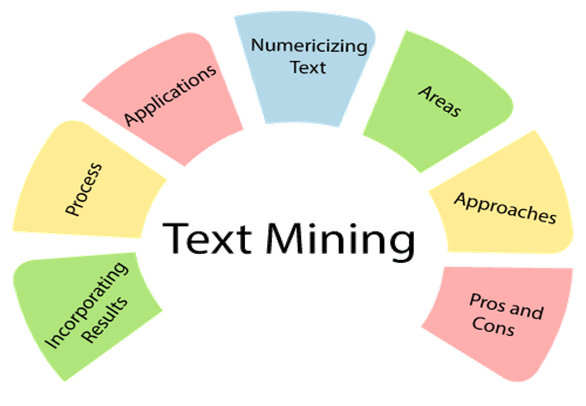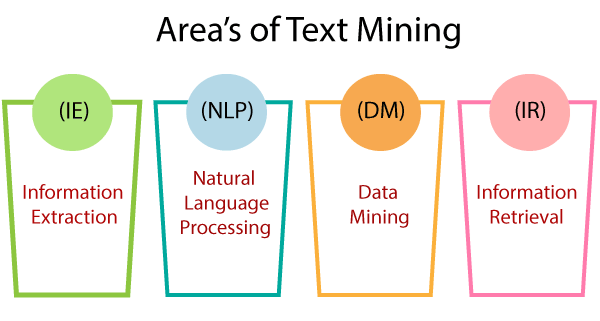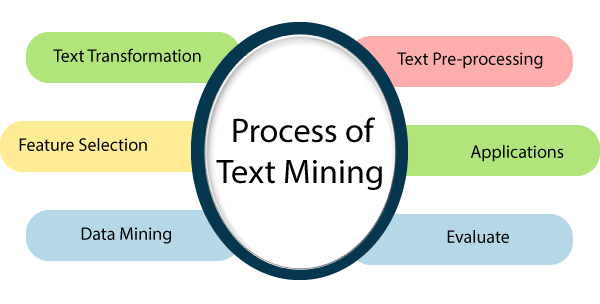Text Data Mining
Text data mining can be described as the process of extracting essential data from standard language text. All the data that we generate via text messages, documents, emails, files are written in common language text. Text mining is primarily used to draw useful insights or patterns from such data.

The text mining market has experienced exponential growth and adoption over the last few years and also expected to gain significant growth and adoption in the coming future. One of the primary reasons behind the adoption of text mining is higher competition in the business market, many organizations seeking value-added solutions to compete with other organizations. With increasing completion in business and changing customer perspectives, organizations are making huge investments to find a solution that is capable of analyzing customer and competitor data to improve competitiveness. The primary source of data is e-commerce websites, social media platforms, published articles, survey, and many more. The larger part of the generated data is unstructured, which makes it challenging and expensive for the organizations to analyze with the help of the people. This challenge integrates with the exponential growth in data generation has led to the growth of analytical tools. It is not only able to handle large volumes of text data but also helps in decision-making purposes. Text mining software empowers a user to draw useful information from a huge set of data available sources.
Areas of text mining in data mining:
These are the following area of text mining :

- Information Extraction:
The automatic extraction of structured data such as entities, entities relationships, and attributes describing entities from an unstructured source is called information extraction.
- Natural Language Processing:
NLP stands for Natural language processing. Computer software can understand human language as same as it is spoken. NLP is primarily a component of artificial intelligence(AI). The development of the NLP application is difficult because computers generally expect humans to "Speak" to them in a programming language that is accurate, clear, and exceptionally structured. Human speech is usually not authentic so that it can depend on many complex variables, including slang, social context, and regional dialects.
- Data Mining:
Data mining refers to the extraction of useful data, hidden patterns from large data sets. Data mining tools can predict behaviors and future trends that allow businesses to make a better data-driven decision. Data mining tools can be used to resolve many business problems that have traditionally been too time-consuming.
- Information Retrieval:
Information retrieval deals with retrieving useful data from data that is stored in our systems. Alternately, as an analogy, we can view search engines that happen on websites such as e-commerce sites or any other sites as part of information retrieval.
Text Mining Process:
The text mining process incorporates the following steps to extract the data from the document.

- Text transformation
A text transformation is a technique that is used to control the capitalization of the text.
Here the two major way of document representation is given.
- Bag of words
- Vector Space
- Text Pre-processing
Pre-processing is a significant task and a critical step in Text Mining, Natural Language Processing (NLP), and information retrieval(IR). In the field of text mining, data pre-processing is used for extracting useful information and knowledge from unstructured text data. Information Retrieval (IR) is a matter of choosing which documents in a collection should be retrieved to fulfill the user's need.
- Feature selection:
Feature selection is a significant part of data mining. Feature selection can be defined as the process of reducing the input of processing or finding the essential information sources. The feature selection is also called variable selection.
- Data Mining:
Now, in this step, the text mining procedure merges with the conventional process. Classic Data Mining procedures are used in the structural database.
- Evaluate:
Afterward, it evaluates the results. Once the result is evaluated, the result abandon.
- Applications:
These are the following text mining applications:
- Risk Management:
Risk Management is a systematic and logical procedure of analyzing, identifying, treating, and monitoring the risks involved in any action or process in organizations. Insufficient risk analysis is usually a leading cause of disappointment. It is particularly true in the financial organizations where adoption of Risk Management Software based on text mining technology can effectively enhance the ability to diminish risk. It enables the administration of millions of sources and petabytes of text documents, and giving the ability to connect the data. It helps to access the appropriate data at the right time.
- Customer Care Service:
Text mining methods, particularly NLP, are finding increasing significance in the field of customer care. Organizations are spending in text analytics programming to improve their overall experience by accessing the textual data from different sources such as customer feedback, surveys, customer calls, etc. The primary objective of text analysis is to reduce the response time of the organizations and help to address the complaints of the customer rapidly and productively.
- Business Intelligence:
Companies and business firms have started to use text mining strategies as a major aspect of their business intelligence. Besides providing significant insights into customer behavior and trends, text mining strategies also support organizations to analyze the qualities and weaknesses of their opponent's so, giving them a competitive advantage in the market.
- Social Media Analysis:
Social media analysis helps to track the online data, and there are numerous text mining tools designed particularly for performance analysis of social media sites. These tools help to monitor and interpret the text generated via the internet from the news, emails, blogs, etc. Text mining tools can precisely analyze the total no of posts, followers, and total no of likes of your brand on a social media platform that enables you to understand the response of the individuals who are interacting with your brand and content.
Text Mining Approaches in Data Mining:
These are the following text mining approaches that are used in data mining.
1. Keyword-based Association Analysis:
It collects sets of keywords or terms that often happen together and afterward discover the association relationship among them. First, it preprocesses the text data by parsing, stemming, removing stop words, etc. Once it pre-processed the data, then it induces association mining algorithms. Here, human effort is not required, so the number of unwanted results and the execution time is reduced.
2. Document Classification Analysis:
Automatic document classification:
This analysis is used for the automatic classification of the huge number of online text documents like web pages, emails, etc. Text document classification varies with the classification of relational data as document databases are not organized according to attribute values pairs.
Numericizing text:
- Stemming algorithms
A significant pre-processing step before ordering of input documents starts with the stemming of words. The terms "stemming" can be defined as a reduction of words to their roots. For example, different grammatical forms of words and ordered are the same. The primary purpose of stemming is to ensure a similar word by text mining program.
- Support for different languages:
There are some highly language-dependent operations such as stemming, synonyms, the letters that are allowed in words. Therefore, support for various languages is important.
- Exclude certain character:
Excluding numbers, specific characters, or series of characters, or words that are shorter or longer than a specific number of letters can be done before the ordering of the input documents.
- Include lists, exclude lists (stop-words):
A particular list of words to be listed can be characterized, and it is useful when we want to search for a specific word. It also classifies the input documents based on the frequencies with which those words occur. Additionally, "stop words," which means terms that are to be rejected from the ordering can be characterized. Normally, a default list of English stop words incorporates "the," "a," "since," etc. These words are used in the respective language very often but communicate very little data in the document.
|



 For Videos Join Our Youtube Channel: Join Now
For Videos Join Our Youtube Channel: Join Now









